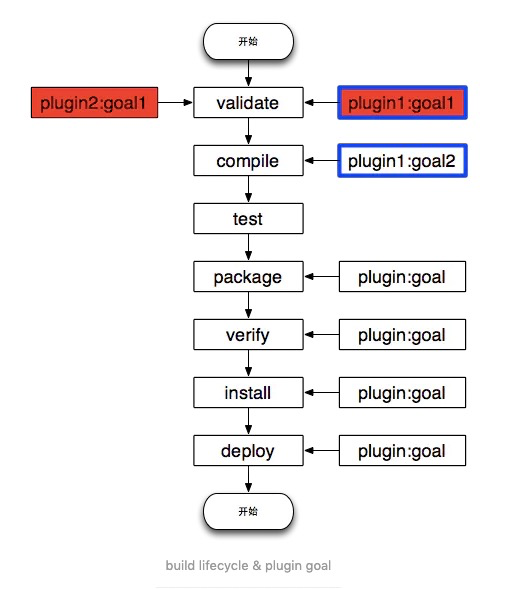Maven 构建生命周期
Maven 构建生命周期就是 Maven 将一个整体任务划分为一个个的阶段,类似于流程图,按顺序依次执行。也可以指定该任务执行到中间的某个阶段结束。
Maven 的内部有三个构建生命周期,分别是 clean, default, site。其中 default 生命周期的核心阶段如下所示:

如何使用构建生命周期来完成构建工作
- 可以指定某个生命周期的阶段
执行 mvn install 命令,将完成 validate, compile, test, package, verify, install 阶段,并将 package 生成的包发布到本地仓库中。其中某些带有连字符的阶段不能通过 shell 命令单独指定。例如:(pre-, post-, or process-*)
1 | mvn install |
- 可以指定多个不同构建生命周期的阶段
执行 mvn clean deploy 命令,首先完成的 clean lifecycle,将以前构建的文件清理,然后再执行 default lifecycle 的 validate, compile, test, package, verify, insstall, deploy 阶段,将 package 阶段创建的包发布到远程仓库中。
1 | mvn clean deploy |
阶段与插件的关系
如上所述,Maven 将构建过程定义为 default lifecycle,并将 default lifecycle 划分为一个个的阶段 phase,这一系列 phase 仅仅是规定执行顺序,至于每个阶段做什么工作?由谁来做?答案就在 插件(plugins) 中。
Maven 对工程的所有操作实实在在的都是由 插件 来完成的。一个插件可以支持多种功能,称之为目标(goal),例如:compiler 插件有两个目标:compile 和 testCompile,分别实现编译源代码 和 编译测试代码。
如何将插件与 Maven 的构建生命周期绑定在一起呢?通过将插件的目标(goal)与 build lifecycle 中 phase 绑定到一起,这样,当要执行某个 phase 时,就调用插件来完成绑定的目标。
如下图所示:从图中可以看出,每一个阶段可以绑定0 个 或 多个目标,每个插件可以提供 1 个或多个目标。

如何为自己的工程创建构建生命周期
- 设置不同的 packaging 类型
在 pom.xml 文件中,packaging 类型支持 jar, war, ear, pom 等多种类型,不同的 packaging 类型会使得不同的 phase 绑定不同的 plugin goal。下面是 packaging 类型为 jar 时,phase 与 plugin goal 的映射关系。
| 阶段 | 目标 |
|---|---|
| process-resources | resources:resources |
| compile | compiler:compile |
| process-test-resources | resources:testResources |
| test-compile | compiler:testCompile |
| test | surefire:test |
| package | jar:jar |
| install | install:install |
| deploy | deploy:deploy |
- 配置 plugin
在 pom.xml 文件中,
例如:将插件 modello-maven-plugin 的 java 目标绑定到 generate-sources 阶段。
1 | <plugin> |
我没有在 pom.xml 指定任何 plugin,但是也能正常构建工程
你可以能会疑问,默认的 pom.xml 文件并没有配置各种 plugin,但是也能正常构建工程?答案是 Maven 自己默认指定了 plugin。
下面是一个没有配置任何 plugin 的 pom.xml,执行 mvn install 的输出日志,从日志中可以看到 一系列的 插件(plugin):版本号:目标(phase),例如: maven-resources-plugin:2.6:resources (default-resources),maven-compiler-plugin:3.1:compile (default-compile) ,maven-resources-plugin:2.6:testResources (default-testResources),maven-compiler-plugin:3.1:testCompile (default-testCompile),maven-surefire-plugin:2.12.4:test (default-test),maven-jar-plugin:2.4:jar (default-jar) ,maven-install-plugin:2.4:install (default-install),
1 | [] Scanning for projects... |
完整的 clean, default, site build lifecycle
- clean lifecycle
| phase | function |
|---|---|
| pre-clean execute | execute processes needed prior to the actual project cleaning |
| clean | remove all files generated by the previous build |
| post-clean | execute processes needed to finalize the project cleaning |
- default lifecycle
| phase | function |
|---|---|
| validate | validate the project is correct and all necessary information is available. |
| initialize | initialize build state, e.g. set properties or create directories. |
| generate-sources | generate any source code for inclusion in compilation. |
| process-sources | process the source code, for example to filter any values. |
| generate-resources | generate resources for inclusion in the package. |
| process-resources | copy and process the resources into the destination directory, ready for packaging. |
| compile | compile the source code of the project. |
| process-classes | post-process the generated files from compilation, for example to do bytecode enhancement on Java classes. |
| generate-test-sources | generate any test source code for inclusion in compilation. |
| process-test-sources | process the test source code, for example to filter any values. |
| generate-test-resources | create resources for testing. |
| process-test-resources | copy and process the resources into the test destination directory. |
| test-compile | compile the test source code into the test destination directory |
| process-test-classes | post-process the generated files from test compilation, for example to do bytecode enhancement on Java classes. For Maven 2.0.5 and above. |
| test | run tests using a suitable unit testing framework. These tests should not require the code be packaged or deployed. |
| prepare-package | perform any operations necessary to prepare a package before the actual packaging. This often results in an unpacked, processed version of the package. (Maven 2.1 and above) |
| package | take the compiled code and package it in its distributable format, such as a JAR. |
| pre-integration-test perform | actions required before integration tests are executed. This may involve things such as setting up the required environment. |
| integration-test | process and deploy the package if necessary into an environment where integration tests can be run. |
| post-integration-test | perform actions required after integration tests have been executed. This may including cleaning up the environment. |
| verify | run any checks to verify the package is valid and meets quality criteria. |
| install | install the package into the local repository, for use as a dependency in other projects locally. |
| deploy | done in an integration or release environment, copies the final package to the remote repository for sharing with other developers and projects. |
- site lifecycle
| phase | function |
|---|---|
| pre-site | execute processes needed prior to the actual project site generation |
| site | generate the project’s site documentation |
| post-site | execute processes needed to finalize the site generation, and to prepare for site deployment |
| site-deploy | deploy the generated site documentation to the specified web server |
作者:data4
链接:https://www.jianshu.com/p/fd43b3d0fdb0
来源:简书
著作权归作者所有。商业转载请联系作者获得授权,非商业转载请注明出处。
